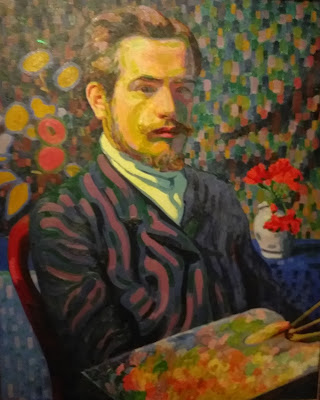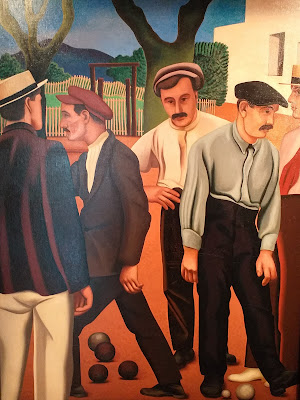Auguste Herbin was a contemporary of Picasso and a very talented painter, but sadly, unlike the latter, hardly anybody has heard of him nowadays.
The Montmartre Museum does a good job of turning the spotlight on him in their latest exhibition. Auguste Herbin was born in a small town near Cateau-Cambrésis in the North of France. He studied art at the Lille Fine Arts school, under an academic painter with the impressive name of Pharaon de Winter.
 |
| Autoportrait (Self portrait) 1906 Kröller-Müller Museum, Otterlo |
Starting with a refined pointillist style Herbin explored the different twentieth century movements: fauvism, cubism and the 'return to order' after World War 1. His last style was geometric abstraction, being one of the leaders of the "Abstract-Creation" group in 1930s Paris.
 |
| Toits de Paris sous la neige (Paris roofs under snow) 1902 Private Collection |
During the 1st world war, Herbin, who was too short to serve as a soldier, worked in an aeroplane manufacture. As with Fernand Leger, this must have given him a certain feeling for machines.
He always liked strong colours. His portrait of a young girl shows the influence of Fauvism:
 |
| Portrait de jeune fille (Portrait of a young girl) 1907 Wuppertal, Von der Heydt Museum |
He painted 3 portraits of fellow artist Battaglia, one of the founder members of the Salon des Indépendents in 1884, using bright patches of colour, like a fauvist Cézanne:
 |
| Portrait of painter Battaglia 1906 Private Collection |
Cézanne's influence is apparent in the following landscape by Herbin:
 |
| Paysage à Hardricourt (Landscape at Hardricourt) 1911 Kröller-Müller Museum, Otterlo |
The forms of cubism attracted Herbin:
 |
| Nature morte avec carafe et plante (Still life with carafe and plant) 1909 |
An anonymous photo of 1911 shows Herbin, aged 28, standing in Picasso's studio boulevard de Clichy, surrounded by Picasso's canvases:
Herbin had taken over Picasso's studio at the Bateau-Lavoir in 1909. He exhibited with the cubists between 1908 and 1913.
 |
| Compotier, carafe et oranges (Fruit dish, carafe and oranges) 1912 Kröller-Müller Museum, Ottelo |
A painting by Herbin at the beginning of the war combines abstract construction with realism. It portrays a family- dynamic and monumental:
 |
| La famille, femmes et enfants (The family, women and children) 1914 Musée d'Art moderne, Paris |
By the end of the war, Herbin's cubist compositions had become more abstract. The spectator enjoys the pleasure of a vase of flowers, translated into an evocative pattern of interlocking colours:
 |
| Composition 1915 Private Collection, Switzerland |
After the First World War, Herbin argued that art should be renewed in a monumental form for modern society. His monumental shapes did not really catch on, but he was in the same line of thought as the Bauhaus and Constructivist artists. He did some work for Léonce Rosenberg, art dealer patron of avant garde art:
There is an exhibition at the moment at the Picasso museum (until 19th May 2024) showing work by De Chirico, Ernst, Leger, Picabia and others whose paintings Rosenberg displayed in his 11-room appartment in the 16th district of Paris.
An abstract tondo painted after the war demonstrates Herbin's originality. The work could be hung any way up:
 |
| Composition circulaire (Circular composition) 1918 Private Collection |
Herbin created several objects for households- furniture and even a piano. An example of his utilitarian creations in this show is a large mirror of 1921 :
 |
| Polychrome relief around mirror 1920 Private Collection |
What might be described as Herbin's "return to order" period, after World War One, is represented by his portrayal of petanque players:
 |
| Les Joueurs de boules No. 2 (Petanque players No. 2) 1923 Pompidou Centre |
Two still lifes further illustrate his neoclassical style of the 1920s:
 |
| Nature morte aux poivrons, choux rouges (Still life with peppers, red cabbage) 1926 Musée des Beaux- Arts, Orléans |
 |
| Les Concombres (The cucumbers) 1926 Collection Lahumière |
In the thirties, Herbin experimented with organic forms and lyrical curves reflecting musical rhythms:
 |
| Composition sur fond blanc (Composition on white background) 1932 Collection Lahumière |
His "Birdman" was inspired by an airshow he visited. Herbin owned a book about pilot Louis Blériot, a native like himself of Cateau-Cambrésis:
 |
| L'homme oiseau II (Birdman II) 1932 Collection Lahumière |
19C poet and art critic Charles Baudelaire had written about the 'correspondances' between the senses. Herbin, always a lover of poetry and philosophy, took it further, exploring the connection between colours, perfumes and letters or musical notes.
During an isolated period in World War Two, he developed a complete alphabet of shapes and colours corresponding to each of the 26 letters of the alphabet. He then made pictures representing words. For example, with H being equal to yellowy orange, E = red, R= light blue, B= purply red, I= orangey and N= white, the following painting spells out "HERBIN":
 |
| Herbin 1959 Private Collection |
Modern studies into synesthesia discuss people who see letters in colour or experience tastes when seeing a certain scene. However, Herbin's system was a language of his own invention. The title painting for the exhibition spells out "Lune" (Moon) (lemon yellow, blue, white and red):
 |
| Lune (Moon) 1945 Collection Lahumière |
One of the works on loan here is from the Matisse Museum in Le Cateau-Cambrésis. Matisse- that other master of colour- came from the same Northern town:
 |
| Charme (Charm) 1959 Private collection on deposit in Musée Matisse, Le Cateau-Cambrésis |
Herbin published an essay: "L'art non-figuratif non-objectif" (Non-figurative non-objective art) where he makes links with the Old Testament (where only non-representational art is sanctioned) . He wrote:
"The meaning of creative truth may be identified with the meaning of God's commandments... Religion, Art and Science, these three activities essential to humans meet on the same spiritual level."
Herbin inspired a second generation of abstract artists: Vasarely, Jean Dewasne, Olle Baerting, Richard Mortenson or Robert Jacobsen. They regarded Herbin as their master. Hence the subtitle of this exhibition: "Auguste Herbin: le maître révélé" (the master revealed). Echoes of Herbin's work are to be found in successive generations, such as the American abstract artists of the 50s and 60s.
His last word painting (unfinished) was appropriately : FIN
 |
| Musée de Montmartre |
The Montmartre Museum, somewhat off the beaten track for tourists, is a haven of peace in busy Montmartre. A simple slide show tells the history of the Franco Prussian war and the Commune revolution of 1871 in Montmartre through the eyes of painter Suzanne Valadon (Utrillo's mother). Her studio there is open for visits.
"Auguste Herbin - le maître révéle" exhibition until 15th September 2024
Musée de Montmartre, 12 rue Cortot, Paris 18e
Metro: Lamarck Caulaincourt
***************



Comments
Post a Comment